SUBFAMILY MYRMICINAE - Genus Paedalgus
| The Ants of
Africa SUBFAMILY MYRMICINAE - Genus Paedalgus |
|
| Contents - Myrmicinae - Carebara sensu Fernandez - Introduction |
In Tribe PHEIDOLOGETONINI. Revised by Bolton & Belshaw (1993).
Now [November 2007] regarded by Fernández (2004) as in the genus Carebara
![]() . I am not persuaded that
lumping what appear to be disparate groups of species is entirely
helpful or necessarily justified.
. I am not persuaded that
lumping what appear to be disparate groups of species is entirely
helpful or necessarily justified.
Diagnostic Features - Mandibles with four teeth. Clypeus longitudinally bicarinate. Eyes present, minute, of one or two ommatidia only. Antennae 9-segmented with a 2-segmented club; octatus antennae with only 8 segments. Promesonotal suture absent; metanotal groove not impressed. Dorsum of alitrunk with sharp lateral margins; propodeum unarmed.
Forel's (1911i) genus definition is at ![]()
Once thought that all were associated with termites. Paedalgus termitolestes, first described by Wheeler (1922) was found as a colony living in a mound-shaped termitarium, and was listed as a specialist termite feeder by Hölldobler & Wilson (1990, page 566). Wheeler, however, noted that whether it fed on the termites or on the mycelium of the fungus cultivated by the termites was not resolved. Newer findings, especially of P. distinctus show instances of apparent leaf litter foraging and of tending Homoptera. Bernard (1952) reported that, although none were found in the Mt. Nimba, Guinea, surveys, the genus was well represented in Ivory Coast and Congo.
Key to workers: (developed from Bolton & Belshaw, 1993)
| ¤ | Queen only known | South Sudan - sudanensis |
| 1 | Dorsum of head behind frontal lobes, entire dorsal alitrunk, and basal half of first gastral tergite, entirely lacking standing hairs | 2 |
| -- | Conspicuous standing hairs obvious | 3 |
| 2 | 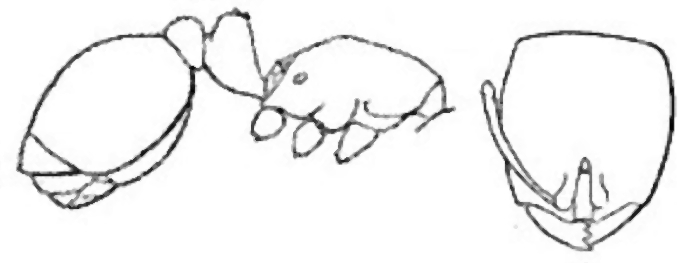 Mandible with 4
teeth; eyes with a single ommatidium;
alitrunk without a shallow depression at the promesonotal suture; TL
1.0-1.1 mm Mandible with 4
teeth; eyes with a single ommatidium;
alitrunk without a shallow depression at the promesonotal suture; TL
1.0-1.1 mm |
. |
| . | 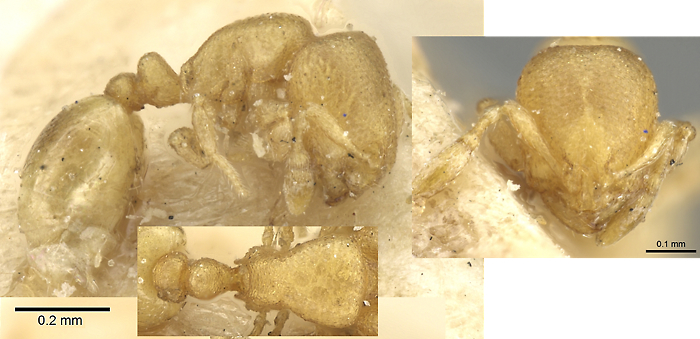 |
Guinea - infimus |
| -- | 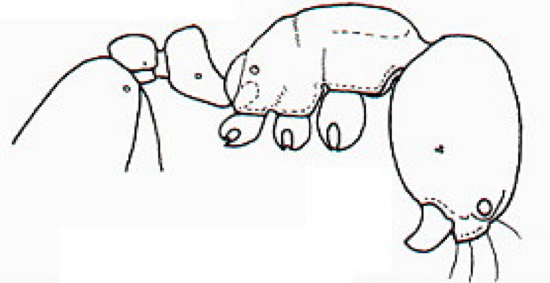 Mandible with 5
teeth; eyes with a 2-3 (4) ommatidium;
alitrunk with a shallow depression or step at the promesonotal suture;
TL 1.4-1.5 mm Mandible with 5
teeth; eyes with a 2-3 (4) ommatidium;
alitrunk with a shallow depression or step at the promesonotal suture;
TL 1.4-1.5 mm |
. |
| . | 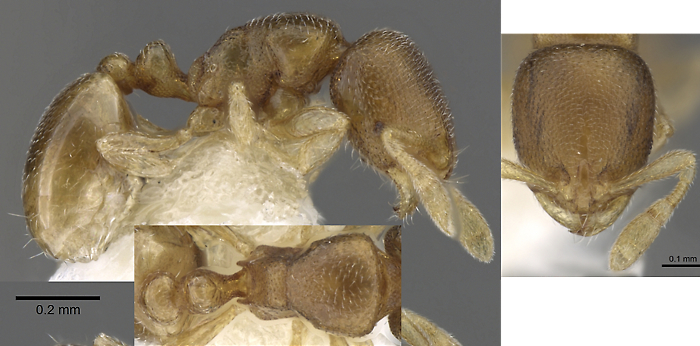 |
South Africa - robertsoni |
| 3 | Dorsal (outer) surface of middle and hind tibiae with short curved pubescence only; TL 1.0 mm | 4 |
| -- | Dorsal (outer) surface of middle and hind tibiae with short curved decumbent to adpressed pubescence which is directed apically; and tibiae with a number of long straight and projecting erect hairs | 5 |
| 4 |  Leading edge of scape
with 2 long straight hairs; TL 1.0 mm Leading edge of scape
with 2 long straight hairs; TL 1.0 mm |
. |
| . | 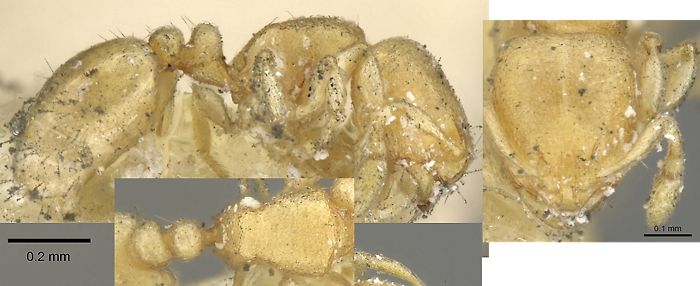 |
Zaďre - termitolestes |
| -- | 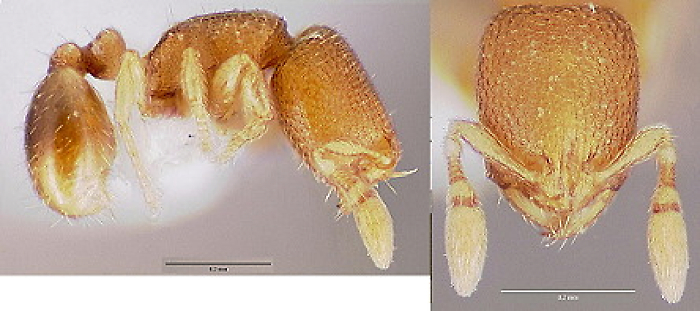 Antennae with 8
segments; leading edge of scape without
long hairs; TL 1.0 mm Antennae with 8
segments; leading edge of scape without
long hairs; TL 1.0 mm |
Kenya - octatus |
| 5 | 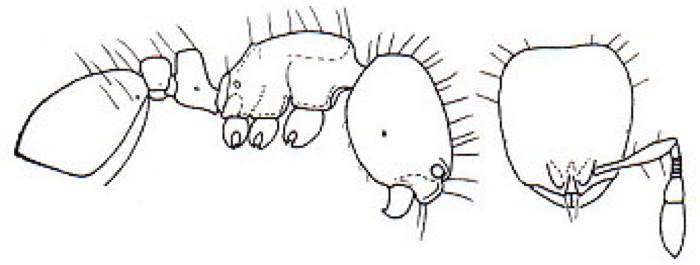 Erect to suberect
standing hairs on first gastral tergite
confined to the basal half; TL 1.2-1.4 mm Erect to suberect
standing hairs on first gastral tergite
confined to the basal half; TL 1.2-1.4 mm |
. |
| . | 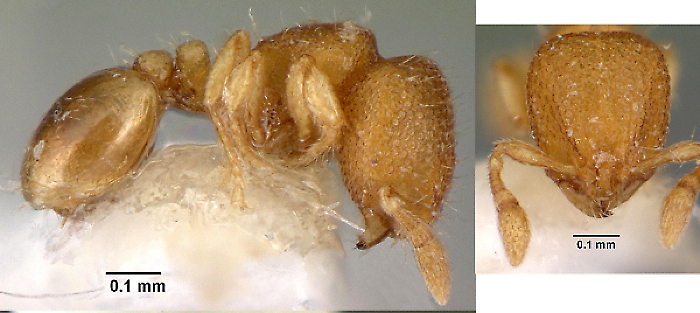 |
West Africa - distinctus |
| -- | Erect to suberect hairs over all of first gastral tergite | 6 |
| 6 | 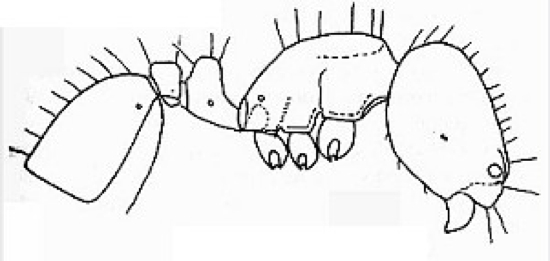 Head and body uniform
dark brown, legs yellow; propodeal
lobes short and narrow, sides of propodeal declivity with angular sides
but without a distinct margin TL 1.2-1.4 mm Head and body uniform
dark brown, legs yellow; propodeal
lobes short and narrow, sides of propodeal declivity with angular sides
but without a distinct margin TL 1.2-1.4 mm |
. |
| . | 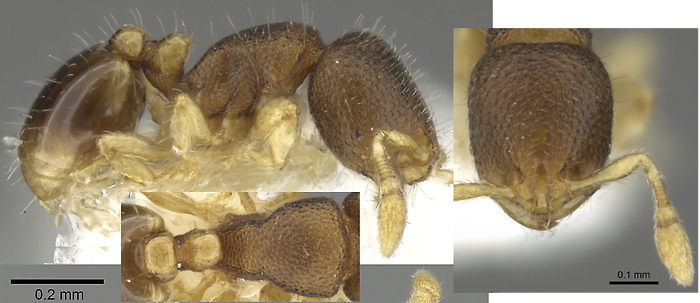 |
Ghana - saritus |
| -- | Head and body uniformly yellow; propodeal lobes long and broad, sides of propodeal declivity with distinct raised margins | 7 |
| 7 | 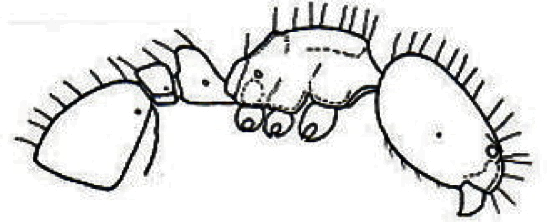 Head in profile with
long erect hairs behind the frontal
lobes; propodeum raised into a triangular peak; pronotum with sharply
angled humeri; TL 1.4 mm Head in profile with
long erect hairs behind the frontal
lobes; propodeum raised into a triangular peak; pronotum with sharply
angled humeri; TL 1.4 mm |
. |
| . | 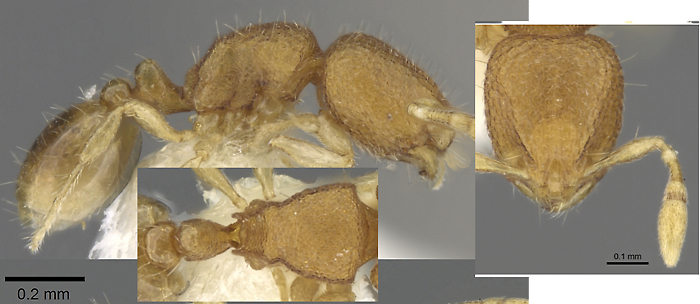 |
Kenya & Cameroun - rarus |
| -- | 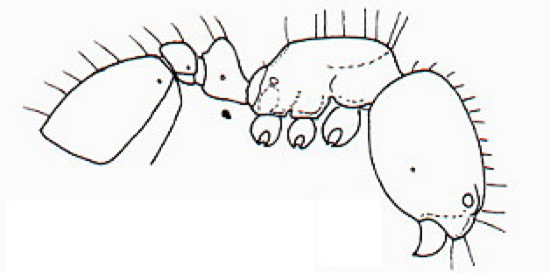 Head in profile with
short erect hairs behind the frontal
lobes; propodeum not raised into a triangular peak; pronotum with
rounded humeri; TL 1.3 mm Head in profile with
short erect hairs behind the frontal
lobes; propodeum not raised into a triangular peak; pronotum with
rounded humeri; TL 1.3 mm |
. |
| . | 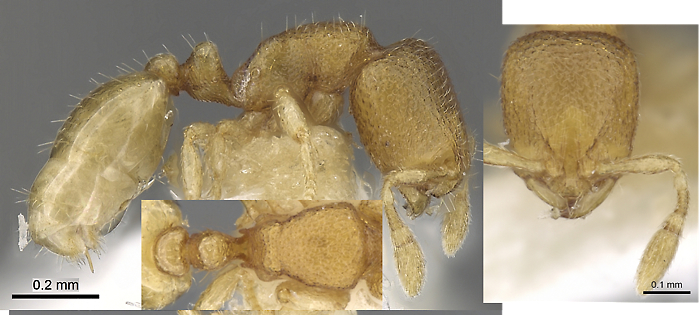 |
Kenya - pisinnus |
| MYRMICINAE Introduction |
© 2007, 2010, 2013 - Brian Taylor CBiol FSB FRES 11, Grazingfield, Wilford, Nottingham, NG11 7FN, U.K. |
href="paedalgus.htm"